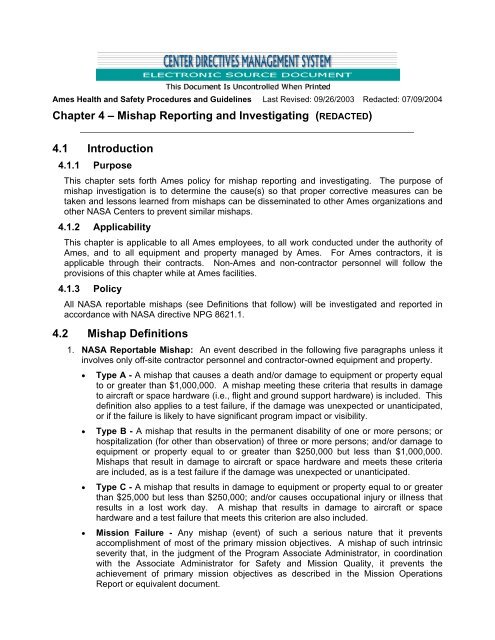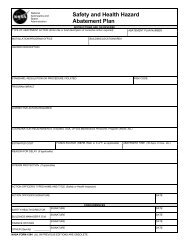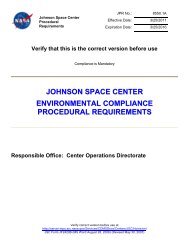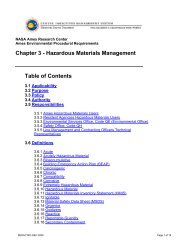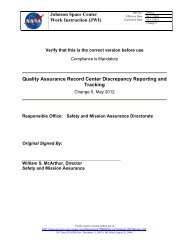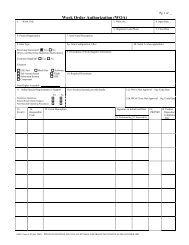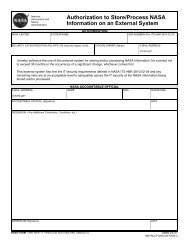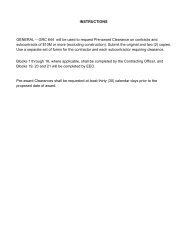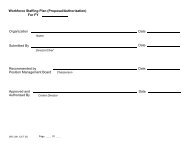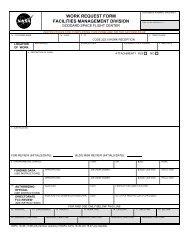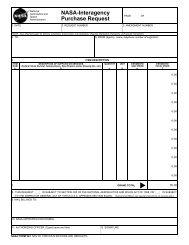Chapter 4 â Mishap Reporting and Investigating ... - NASA
Chapter 4 â Mishap Reporting and Investigating ... - NASA
Chapter 4 â Mishap Reporting and Investigating ... - NASA
You also want an ePaper? Increase the reach of your titles
YUMPU automatically turns print PDFs into web optimized ePapers that Google loves.
Ames Health <strong>and</strong> Safety Procedures <strong>and</strong> Guidelines Last Revised: 09/26/2003 Redacted: 07/09/2004<br />
<strong>Chapter</strong> 4 – <strong>Mishap</strong> <strong>Reporting</strong> <strong>and</strong> <strong>Investigating</strong> (REDACTED)<br />
4.1 Introduction<br />
4.1.1 Purpose<br />
This chapter sets forth Ames policy for mishap reporting <strong>and</strong> investigating. The purpose of<br />
mishap investigation is to determine the cause(s) so that proper corrective measures can be<br />
taken <strong>and</strong> lessons learned from mishaps can be disseminated to other Ames organizations <strong>and</strong><br />
other <strong>NASA</strong> Centers to prevent similar mishaps.<br />
4.1.2 Applicability<br />
This chapter is applicable to all Ames employees, to all work conducted under the authority of<br />
Ames, <strong>and</strong> to all equipment <strong>and</strong> property managed by Ames. For Ames contractors, it is<br />
applicable through their contracts. Non-Ames <strong>and</strong> non-contractor personnel will follow the<br />
provisions of this chapter while at Ames facilities.<br />
4.1.3 Policy<br />
All <strong>NASA</strong> reportable mishaps (see Definitions that follow) will be investigated <strong>and</strong> reported in<br />
accordance with <strong>NASA</strong> directive NPG 8621.1.<br />
4.2 <strong>Mishap</strong> Definitions<br />
1. <strong>NASA</strong> Reportable <strong>Mishap</strong>: An event described in the following five paragraphs unless it<br />
involves only off-site contractor personnel <strong>and</strong> contractor-owned equipment <strong>and</strong> property.<br />
• Type A - A mishap that causes a death <strong>and</strong>/or damage to equipment or property equal<br />
to or greater than $1,000,000. A mishap meeting these criteria that results in damage<br />
to aircraft or space hardware (i.e., flight <strong>and</strong> ground support hardware) is included. This<br />
definition also applies to a test failure, if the damage was unexpected or unanticipated,<br />
or if the failure is likely to have significant program impact or visibility.<br />
• Type B - A mishap that results in the permanent disability of one or more persons; or<br />
hospitalization (for other than observation) of three or more persons; <strong>and</strong>/or damage to<br />
equipment or property equal to or greater than $250,000 but less than $1,000,000.<br />
<strong>Mishap</strong>s that result in damage to aircraft or space hardware <strong>and</strong> meets these criteria<br />
are included, as is a test failure if the damage was unexpected or unanticipated.<br />
• Type C - A mishap that results in damage to equipment or property equal to or greater<br />
than $25,000 but less than $250,000; <strong>and</strong>/or causes occupational injury or illness that<br />
results in a lost work day. A mishap that results in damage to aircraft or space<br />
hardware <strong>and</strong> a test failure that meets this criterion are also included.<br />
• Mission Failure - Any mishap (event) of such a serious nature that it prevents<br />
accomplishment of most of the primary mission objectives. A mishap of such intrinsic<br />
severity that, in the judgment of the Program Associate Administrator, in coordination<br />
with the Associate Administrator for Safety <strong>and</strong> Mission Quality, it prevents the<br />
achievement of primary mission objectives as described in the Mission Operations<br />
Report or equivalent document.
<strong>Chapter</strong> 4 – <strong>Mishap</strong> <strong>Reporting</strong> <strong>and</strong> <strong>Investigating</strong> (REDACTED) Page 2 of 7<br />
• Incident - A mishap of less than Type C injury, but more than first-aid severity<br />
(recordable) <strong>and</strong>/or property damage equal to or greater than $1000 but less than<br />
$25,000.<br />
2. Close Call - An occurrence in which there is no injury or an injury of first-aid severity, no<br />
significant equipment property damage (less than $1000), <strong>and</strong> no significant interruption of<br />
productive work, but which possesses a high potential for any of the mishaps as defined in<br />
paragraph 1.<br />
3. Incident Comm<strong>and</strong>er - The individual responsible for the management of all operations at<br />
the scene of an emergency incident.<br />
4. Emergency Incident - A combination of circumstances that calls for immediate action in<br />
response to an alarm.<br />
5. Alarm - An audible or visible signal indicating an off-st<strong>and</strong>ard or abnormal condition.<br />
6. <strong>Mishap</strong> - An unplanned, undesired event that results in personal injury or property damage.<br />
4.3 References<br />
▪<br />
▪<br />
▪<br />
NPG 8715.3, <strong>NASA</strong> Safety Manual<br />
NPD 8621.1 <strong>NASA</strong> <strong>Mishap</strong>, <strong>and</strong> Close Call <strong>Reporting</strong>, <strong>Investigating</strong>, <strong>and</strong> Recordkeeping<br />
Policy<br />
NPG 8621.1, <strong>NASA</strong> Procedures <strong>and</strong> Guidelines for <strong>Mishap</strong> <strong>Reporting</strong>, <strong>Investigating</strong> <strong>and</strong><br />
Recordkeeping<br />
4.4 Non-emergency <strong>Mishap</strong>s<br />
4.4.1 Occupational Injuries or Illness<br />
Occupational injuries that are recordable under occupational injury reporting regulations are<br />
reportable as mishaps. Any work-related or injury that requires medical attention greater than<br />
first aid is recorded as an Incident. A work-related illness or injury that results in one or more<br />
lost workdays after the day of the injury is reportable as a Type C mishap.<br />
When an employee is injured, his/her supervisor is responsible for completing the unshaded<br />
portions of a <strong>Mishap</strong> Report (<strong>NASA</strong> Form 1627) <strong>and</strong> submitting the first page to the Safety<br />
Division. That first page of the mishap report, or the same information by other means, shall be<br />
delivered to the Safety Division within 24 hours after learning of the mishap. Note: Usually a<br />
representative of the Safety Division responds to the Ames Health Unit when a patient is being<br />
seen for a recordable injury or illness, <strong>and</strong> gathers the pertinent data at that visit.<br />
Upon completion of the supervisor's investigation of the injury, <strong>and</strong> within ten workdays, the<br />
supervisor is responsible for completing the second part of the Form 1627 <strong>and</strong> submitting it to<br />
the Safety Division.<br />
Any incident that involves a bloodborne pathogen exposure always requires follow-up by the<br />
Ames Health Unit.<br />
The supervisor must consult with Ames Health & Safety Manual <strong>Chapter</strong> 32, Bloodborne<br />
Pathogens Protection Plan, for guidance. The information on the form "Exposure Incident<br />
Description" should be attached to the initial mishap report. The information on the form<br />
"Follow-Up Evaluation of Exposure Incident" should be attached to the final mishap report.<br />
4.4.2 Property Damage <strong>Mishap</strong>s<br />
<strong>Mishap</strong>s for which no emergency actions are needed are h<strong>and</strong>led in the same way as those<br />
requiring emergency assistance. Personnel must follow applicable portions of the guidance in<br />
section 4.5 that follows.
<strong>Chapter</strong> 4 – <strong>Mishap</strong> <strong>Reporting</strong> <strong>and</strong> <strong>Investigating</strong> (REDACTED) Page 3 of 7<br />
4.5 Emergency Incidents that Require Help<br />
4.5.1 Responsibilities of Employees<br />
The most capable person at the scene of a mishap that requires emergency assistance acts as<br />
the Incident Comm<strong>and</strong>er <strong>and</strong> ensures appropriate emergency response until relieved of this<br />
duty by emergency response personnel, a representative of the Safety Division, senior<br />
management, the Ames Fire Department, Ames Security Police, or other authorized personnel.<br />
All personnel will support emergency response/mitigative actions to the best of their ability, as<br />
directed by the Incident Comm<strong>and</strong>er.<br />
1. Immediate Action<br />
▪<br />
▪<br />
▪<br />
▪<br />
▪<br />
▪<br />
▪<br />
▪<br />
▪<br />
Call 9-1-1 from Center phone, or REDACTED<br />
(Dialing 911 from a non-Ames phone or cellular phone will result in your being connected<br />
to an offsite 911 system <strong>and</strong> could delay the response.)<br />
State that there is an emergency.<br />
Describe location (building, room, area, etc.)<br />
Identify yourself <strong>and</strong> your phone number.<br />
Identify the type of emergency — medical, fire, security, toxic spill, etc.<br />
Say how many people need help.<br />
Describe the current situation.<br />
Stay on the phone until you are released. Do not be the one to hang up first.<br />
2. Follow-Up Action<br />
▪<br />
▪<br />
▪<br />
▪<br />
▪<br />
▪<br />
▪<br />
Provide assistance to injured persons.<br />
If appropriate, take action to limit or prevent further injuries <strong>and</strong> damage. Follow facility<br />
emergency procedures in order to reduce hazardous conditions, as appropriate.<br />
Identify witnesses <strong>and</strong> victims.<br />
Control access <strong>and</strong> secure the area to stop actions that could hamper or prevent<br />
investigation of the mishap.<br />
Notify division management in accordance with the division's emergency procedures.<br />
Impound records, data, <strong>and</strong> similar information for future investigation.<br />
Do not relinquish control of the accident scene until relieved by an emergency responder,<br />
a responsible manager, or an Ames Police Officer.<br />
3. Offsite <strong>Mishap</strong>s<br />
Take appropriate emergency action as described above. Work with local officials <strong>and</strong><br />
emergency response personnel in accordance with emergency response plans. As soon as<br />
conditions permit, call the Ames Security Dispatch at REDACTED <strong>and</strong> notify the emergency<br />
operator of the mishap. Immediately report all work-related injuries/illnesses to your supervisor<br />
<strong>and</strong> to the Ames Health Unit.<br />
4.5.2 Responsibilities of Emergency Responders<br />
In addition to any of the previously listed actions that still need to be taken, emergency<br />
responders must preserve the accident scene, consistent with safety, for the impending<br />
investigation. In addition, responders should maintain control of the scene until relieved by a<br />
member of the Safety Division, another emergency responder, an assigned accident<br />
investigator, or the Ames Police.<br />
4.5.3 Responsibilities of Facility Managers<br />
Directors or managers of facilities in which a mishap has occurred must cooperate with<br />
emergency responders <strong>and</strong> investigators in the control of the accident scene, the identification<br />
<strong>and</strong> interview of witnesses, <strong>and</strong> where necessary, the impoundment of records <strong>and</strong> collection<br />
<strong>and</strong> analysis of recorded information to facilitate the investigation.
<strong>Chapter</strong> 4 – <strong>Mishap</strong> <strong>Reporting</strong> <strong>and</strong> <strong>Investigating</strong> (REDACTED) Page 4 of 7<br />
4.5.4 Responsibilities of Ames Security Dispatch<br />
Immediately after requesting the appropriate emergency response, the Ames Security Dispatch<br />
will notify the cognizant supervisor, assigned Safety Division personnel, <strong>and</strong> other appropriate<br />
personnel (per the emergency call list).<br />
4.5.5 Responsibilities of Contractors<br />
Contractors shall investigate all contractor mishaps that do not involve <strong>NASA</strong> property or civil<br />
servants. A copy of the report shall be forwarded to the Safety Division within 10 days unless<br />
approved otherwise by the Safety Division. Report injuries electronically at http://Q on <strong>NASA</strong><br />
Form 1627, <strong>Mishap</strong> Incident Report.<br />
If <strong>NASA</strong> <strong>and</strong> a contractor or resident agency conduct separate but parallel investigations of the<br />
same mishap, the two investigators or boards are encouraged to share fact-finding, data, <strong>and</strong><br />
evidence. However, when it comes to deliberation of conclusions <strong>and</strong> cause(s), each<br />
investigator or board shall act independently of the other. No parallel investigation will be<br />
allowed to impede a <strong>NASA</strong> investigation. Contractors will cc a copy of ARC 15, Contractor<br />
Monthly Accident Report to the Safety Division monthly.<br />
4.6 <strong>Mishap</strong> Investigation & <strong>Reporting</strong><br />
4.6.1 The Investigator<br />
If no emergency responders are on the scene, the responsible supervisor or assigned safety<br />
representative initiates an investigation. If an emergency response has occurred, the<br />
emergency responder maintains control of the mishap scene <strong>and</strong> may proceed with the<br />
investigation until relieved by the Safety Division representative, or a specifically designated<br />
<strong>Mishap</strong> Investigation Board or Investigator.<br />
Note: The Ames Center Director is the appointing authority for the Type B mishaps <strong>and</strong> for<br />
Type A mishaps when so designated.<br />
An onsite investigator has the authority to take all appropriate measures to ensure that a proper,<br />
complete, <strong>and</strong> timely investigation is completed.<br />
The investigator will complete the following as appropriate:<br />
1. Safeguard the site of the mishap until all appropriate physical evidence can be obtained<br />
<strong>and</strong> preserved. Security provides assistance, as directed by the investigator.<br />
2. Identify witnesses <strong>and</strong> victims <strong>and</strong> take their statements.<br />
3. Ensure that appropriate photographs of the mishap site are obtained. An Ames<br />
photographer, under the direction of the investigator, normally does this.<br />
4. Complete <strong>and</strong> submit an initial report of the mishap on a <strong>NASA</strong> Form 1627. Initial reports<br />
must be submitted to the Safety Division within 24 hours of the mishap.<br />
5. Complete a formal investigation report (Type A or B) in accordance with guidance in NPG<br />
8621.1, <strong>and</strong> submit it to the appointing authority.<br />
6. Complete a formal investigation report (Type C, when requested) in accordance with<br />
guidance provided by the appointing authority.<br />
The membership of a formal mishap investigation board (A or B) does not include anyone from<br />
the organization responsible for the mishap, unless required for expertise.<br />
The organization responsible for the mishap is responsible for the cost of the investigation.<br />
All mishap reports, both Forms 1627 <strong>and</strong> formal reports, shall include the investigator's best<br />
estimate of the dollar value of damage resulting from the mishap.
<strong>Chapter</strong> 4 – <strong>Mishap</strong> <strong>Reporting</strong> <strong>and</strong> <strong>Investigating</strong> (REDACTED) Page 5 of 7<br />
4.6.2 Safety Office<br />
1. A Safety Office on-call representative responds to each mishap as necessary to be a focus<br />
of Safety Office support <strong>and</strong> provide immediate technical expertise as appropriate. The<br />
Safety Office representative shall:<br />
Determine the mishap type (see definitions in section 4.2 of this chapter or NMI 8621.1,<br />
"<strong>Mishap</strong> <strong>Reporting</strong> <strong>and</strong> <strong>Investigating</strong>"). If a Type A or B mishap, the Safety Division notifies<br />
the Deputy Director or Director, the Public Information Officer, <strong>and</strong> the <strong>NASA</strong> Safety<br />
Division at Headquarters. The Safety Division submits a Telephone Initial <strong>Mishap</strong> Report<br />
(<strong>NASA</strong> Form 1627A) within 24 hours of the mishap (except as stated below).<br />
For Type A mishaps involving a fatality, or Type B mishaps involving the hospitalization of<br />
three or more <strong>NASA</strong> employees (or a combination of three <strong>NASA</strong> <strong>and</strong> non-<strong>NASA</strong><br />
personnel), notification to <strong>NASA</strong> Headquarters Safety Division must be made within a few<br />
hours to support Headquarters notification to Federal OSHA within 8 hours.<br />
The following telephone numbers are available for these calls:<br />
▪<br />
▪<br />
▪<br />
▪<br />
M-F, 8 am to 5 pm EST — REDACTED (Safety Division Chief Office)<br />
M-F, 5 pm to 8 pm EST — REDACTED (Safety Division Chief Mobile)<br />
M-F, back-up number — REDACTED (Safety Program Manager)<br />
Off-shift — REDACTED<br />
For events involving Weapons of Mass Destruction anytime — REDACTED<br />
2. Ensure that reporting requirements of this chapter are met <strong>and</strong> that a proper investigation is<br />
conducted in accordance with applicable regulations <strong>and</strong> st<strong>and</strong>ards.<br />
3. Verify that appropriate measures have been taken, or are taken, to secure the mishap<br />
scene to protect personnel from the hazards <strong>and</strong> to preserve evidence for the investigation.<br />
4. Assure that appropriate defensive <strong>and</strong> offensive measures have been taken, or are taken,<br />
to protect life/health, the environment, <strong>and</strong> property.<br />
5. Notify appropriate Organizational Director(s).<br />
6. Input information from mishap reports into the Incident <strong>Reporting</strong> <strong>and</strong> Information System<br />
(IRIS), the <strong>NASA</strong> agency-wide mishap reporting database. This database is hosted by<br />
Headquarters <strong>and</strong> provides a means for exchanging mishap information with the other<br />
<strong>NASA</strong> centers. The information is used to analyze trends <strong>and</strong> disseminate lessons-learned<br />
information for prevention of future mishaps.<br />
The Safety Office typically provides the following additional support to investigation boards <strong>and</strong><br />
committees:<br />
1. System safety support<br />
2. Direct consulting services<br />
3. Tracking of corrective actions<br />
4. Trending <strong>and</strong> analysis of mishap causes<br />
5. Advise <strong>and</strong> consult with the Center Director on staffing of investigation boards<br />
The Safety Office also distributes a summary of each major mishap report, including findings<br />
<strong>and</strong> recommendations, to all Ames staff to whom the lessons could be of value.
<strong>Chapter</strong> 4 – <strong>Mishap</strong> <strong>Reporting</strong> <strong>and</strong> <strong>Investigating</strong> (REDACTED) Page 6 of 7<br />
4.7 Appendix A: <strong>Mishap</strong> Responsibilities <strong>and</strong> Timeline<br />
Action By Whom When<br />
Report to Ames Health Unit Employee As soon as able after a<br />
nonemergency illness or<br />
injury<br />
Dial 9-1-1/Ames Security<br />
Dispatch for immediate<br />
response<br />
Notify Ames Health Unit (if<br />
medical emergency)<br />
Emergency treatment<br />
Notify Safety Office &<br />
supervisor (Type A, B, & C<br />
mishaps)<br />
Assume control of mishap<br />
scene (if applicable)<br />
Notify Director <strong>and</strong> HQ /<br />
Code QS (Type A, B, <strong>and</strong><br />
Mission Failure mishaps)<br />
Notify Public Affairs Director<br />
(if applicable)<br />
Initiate conference for<br />
investigation board<br />
appointment (Type A & B, &<br />
sometimes C)<br />
Send board appointment<br />
letters (if applicable)<br />
Complete a Telephonic<br />
<strong>Mishap</strong> Report, <strong>NASA</strong> Form<br />
1627A (if HQ notified)<br />
Completed <strong>NASA</strong> Form 1627<br />
(unshaded sections) <strong>and</strong><br />
send to Safety Office<br />
Completed<br />
Compensation/Insurance<br />
Forms CA-1 or CA-2<br />
(Federal employees)<br />
Enter data into <strong>NASA</strong><br />
database<br />
Complete CA-16, sheet 1<br />
(Federal employees)<br />
Board convenes (if<br />
applicable)<br />
Send interim (2 week) status<br />
report to Appointing Official<br />
(if applicable)<br />
Complete <strong>NASA</strong> Form 1627,<br />
follow-up report<br />
Supervisor or eyewitness to<br />
an emergency mishap<br />
Ames Security Dispatch<br />
Health Unit physician,<br />
ambulance crew,<br />
paramedics<br />
Ames Security Dispatch<br />
<strong>and</strong>/or Ames Health Unit<br />
Cognizant supervisor,<br />
designated representative,<br />
emergency responder<br />
Safety Office representative<br />
Center Director (or, as<br />
delegated, Safety Office)<br />
Appointing Official (HQ if<br />
Type A; Center Director with<br />
HQ concurrence if Type B)<br />
Appointing official<br />
Safety Office representative<br />
Supervisor<br />
Supervisor<br />
Safety Office representative<br />
Ames Heath Unit<br />
Board chairperson<br />
Board chairperson<br />
Immediately<br />
Immediately<br />
Immediately<br />
Immediately<br />
ASAP<br />
ASAP<br />
ASAP to 3 days<br />
ASAP to 3 days<br />
ASAP to 3 days<br />
+1 day<br />
+1 day<br />
+1 day<br />
+1 to 2 days after receipt<br />
+2 days<br />
+3 days<br />
+3 to 5 days, then every two<br />
weeks<br />
Supervisor<br />
+10 days, or on employee's<br />
return to work<br />
Report to Ames Health Unit Employee On employee's return to work
<strong>Chapter</strong> 4 – <strong>Mishap</strong> <strong>Reporting</strong> <strong>and</strong> <strong>Investigating</strong> (REDACTED) Page 7 of 7<br />
Action By Whom When<br />
Complete Form ARC 215 Ames Health Unit physician On employee's return to work<br />
Medical Disposition<br />
Verify corrective actions<br />
implemented (if no board<br />
investigation)<br />
Safety Office representative Prior to close-out<br />
Note: All remaining steps are applicable only if mishaps have a board investigation.<br />
Action By Whom When<br />
Send undated board report Board Chairperson<br />
+60 days<br />
(all volumes) to Appointing<br />
Official<br />
Accept or reject report Appointing Official +80 days<br />
Develop formal Corrective Appointing Official/board +80 days<br />
Action Plan<br />
Forward 15 copies of report Appointing Official<br />
+80 days<br />
<strong>and</strong> CA Plan to Director/QS<br />
Concur <strong>and</strong> date report Director/QS +105 days<br />
Dismiss board, publish <strong>and</strong><br />
distribute report<br />
Enter appropriate final<br />
mishap information into<br />
<strong>NASA</strong> Incident <strong>Reporting</strong><br />
Information System (IRIS)<br />
database Safety<br />
Appointing Official<br />
Office representative<br />
+145 days<br />
+160 days


